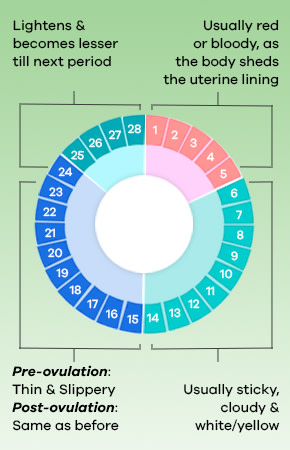Having a Clear Discharge

Vaginal discharge is the fluid that your vaginal and cervix cells normally emit. It protects your body by removing dead skin cells and bacteria from the vaginal area while also maintaining a healthy pH balance. The female reproductive system produces a clear vaginal discharge, which is a typical and normal symptom. Ovulation is marked by clear stretchy discharge, whereas clear, watery discharge before periods, sexual arousal, or pregnancy. A yeast infection, bacterial vaginosis, or menopause can all be symptoms of clear but thick vaginal discharge.
Changes in the consistency and colour of your discharge can occasionally talk about the processes going on in your body.
A Normal Discharge –

A clear or thin white vaginal discharge that is more or less consistent is entirely acceptable. This fine mucus is produced by glands in the cervix and the vaginal walls to protect the vaginal tissues. This keeps the tissues moisturised, preventing them from drying out and becoming irritable, as well as keeping them mildly acidic, which aids in the killing of any harmful bacteria. As it flows out of the vaginal canal, the clear discharge acts as a cleansing mechanism, sweeping away any dead cells or bacteria. At different periods of life, vaginal discharge might change. It takes on a whitish and milky appearance during pregnancy. Because estrogen levels diminish during and after menopause, the discharge decreases. Normal vaginal discharge never cause irritation, has no bad odour, and is always clear or white in colour.
So, what does it mean if I have clear discharge? Here is why you may see a clear, watery discharge –
You are Ovulating

The body creates a transparent fluid that is elastic, sticky, or slippery when ovulating – a clear water discharge. Cervical mucus can indicate a fertile period. The time in your cycle when your body releases an egg for possible fertilisation is known as ovulation. Cervical mucus production increases as you get closer to the end of your cycle. This results in a more profuse, clear, and stretchy discharge. This greater discharge aids in the movement of sperm up the cervix to fertilise the released egg. Vaginal glands create up to 30 times more cervical mucus in the days leading up to ovulation than in the days following ovulation.
You are Pregnant
The walls of the vagina and the cervix soften during pregnancy to create way for a growing foetus. To prevent diseases from spreading up the vaginal canal and into the womb, the body will produce more vaginal discharge. An increase in vaginal discharge is also linked to a rise in progesterone levels. Clear, white discharge that is odourless for the majority of the pregnancy, is a healthy one.
When estrogen levels drop after ovulation, the discharge usually gets drier and thinner. However, if the sperm successfully fertilises an egg, the discharge may remain thick, clear, and stretchy. It could also turn a yellowish hue. This occurs due to the continuous rise in estrogen and progesterone after an egg has been fertilised. It's possible that this heavier discharge will linger for up to eight weeks. The mucus begins to form a mucus plug at this phase, which protects the embryo and cervix.
Remember that cervical mucus changes aren't a foolproof way to determine a pregnancy, but can be a good indicator of when you should get a pregnancy test.
Menopause

Menopause causes various changes in the body, including a decrease in vaginal moisture due to lower estrogen and progesterone levels. Women, on the other hand, continue to produce discharge, albeit in reduced proportions. Clear, non-irritating discharge is preferred at this stage. If the discharge turns yellow or white, it could be an indication of an infection, and you should contact your doctor. Because less anti-bacterial mucus is produced in the vagina, vaginal disruptions such as thrush and bacterial vaginosis become more common after menopause.
Other Causes
Changes in vaginal discharge can be caused by a variety of factors other than ovulation and pregnancy. This is why tracking your cervical mucus isn't the only way to assess fertility.
Workout - Any time throughout the menstrual cycle, a clear, sticky discharge is usual. Ranging in colour from clear to white and watery discharge is produced on a daily basis. The discharge might also be thick or thin, as well as odourless or musky. When women exercise, they may notice an increase in clear, watery discharge. This is completely normal and nothing to be concerned about.
Medication – Hormonal contraceptives (birth control pills) and other drugs might affect vaginal discharge. Cervical fluid can thicken while using combined oral contraceptives that contain both progesterone and estrogen. This helps prevent pregnancy by averting the sperm from accessing the uterus, although it can alter the look of discharge. Some individuals on the pill may notice a consistently clear white discharge throughout the month.
Sexual Arousal - Arousal fluid is produced by glands in and around the vagina when the body is sexually stimulated. Arousal fluid is produced to lubricate and prepare the vagina for the possible contact. Unlike other types of discharge, this usually vanishes within an hour. This fluid is clear, moist, wet, and slick.
The amount of vaginal discharge varies greatly from one person to the other. Depending on where a person is in their menstrual cycle, the colour, consistency, and amount can alter from day to day:

If you experience an odd clear, stretchy discharge that is accompanied by the following symptoms, make an appointment with your doctor.
- a burning sensation in the vaginal area
- fever
- vaginal itching
- painful intercourse
- redness around the vulva
- tenderness around the vulva or vaginal area






